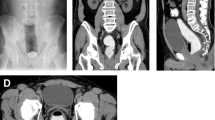Abstract
Retained rectal foreign body is not an uncommon condition, but reliable epidemiological data are not available. The diagnosis and management can present a significant challenge due to delayed presentation and the reluctance of the patients to provide details of the incident. The aim of the clinical evaluation is to identify the type, number, size, shape and location of the foreign body. Removal of retained rectal foreign bodies requires experience, with particular attention to different methods of extracting various objects. Most retained rectal foreign bodies can be successfully extracted transanally under appropriate anaesthesia and only a small proportion, mostly cases of perforation, overt peritonitis, pelvic sepsis or for failure of transanal extraction, will require open surgery or laparoscopy. It is mandatory to perform a proctosigmoidoscopy after anorectal foreign body removal to exclude bowel injury and ensure that the patient has not inserted more than one foreign body. Patients with mucosal abrasion, tears and oedema are to be admitted for a period of observation.









Similar content being viewed by others
References
Ayantunde AA, Oke T (2006) A review of gastrointestinal foreign bodies. Int J Clin Pract 60:735–739
Cohen JS, Sackier JM (1996) Management of colorectal foreign bodies. J R Coll Surg Edinb 41:312–315
Eftaiha M, Hambrick E, Abcarian H (1997) Principles of management of colorectal foreign bodies. Arch Surg 112:691–695
Clarke DL, Buccimazza I, Anderson FA, Thomson SR (2005) Colorectal foreign bodies. Colorectal Dis 7:98–103
Stack LB, Munter DW (1996) Foreign bodies in the gastrointestinal tract. Emerg Med Clin North Am 14:493–521
Goldberg JE, Steele SR (2010) Rectal foreign bodies. Surg Clin North Am 90:173–184
Rodriguez-Hermosa JI, Codina-Cazador A, Ruiz B, Sirvent JM, Roig J, Farres R (2007) Management of foreign bodies in the rectum. Colorectal Dis 9:543–548
Lake JP, Essani R, Petrone P, Kaiser AM, Asensio J, Beart RW Jr (2004) Management of retained colorectal foreign bodies: predictors of operative intervention. Dis Colon Rectum 47:1694–1698
Smith MT, Wong RK (2007) Foreign bodies. Gastrointest Endosc Clin N Am 17:361–382
Berghoff KR, Franklin ME Jr (2005) Laparoscopic-assisted rectal foreign body removal: report of a case. Dis Colon Rectum 48:1975–1977
Koornstra JJ, Weersma RK (2008) Management of rectal foreign bodies: description of a new technique and clinical practice guidelines. World J Gastroenterol 14:4403–4406
Traub SJ, Hoffman RS, Nelson LS (2003) Body packing—the internal concealment of illicit drugs. N Engl J Med 349:2519–2526
Huang WC, Jiang JK, Wang HS et al (2003) Retained rectal foreign bodies. J Chin Med Assoc 66:606–611
Kurer MA, Davey C, Khan S, Chintapatla S (2010) Colorectal foreign bodies: a systematic review. Colorectal Dis 12:851–861
Nehme Kingsley A, Abcarian H (1985) Colorectal foreign bodies: management update. Dis Colon Rectum 28:941–944
Cirocco WC (2000) Anesthesia facilitates the extraction of rectal foreign bodies. Gastrointest Endosc 52:452–453
Levin SE, Cooperman H, Freilich M, Lomas M (1977) The use of a curved uterine vulsellum for removal of rectal foreign bodies: report of a case. Dis Colon Rectum 20:533
Couch CJ, Tan EG, Watt AG (1986) Rectal foreign bodies. Med J Aust 144:512–515
Sharma H, Banka S, Walton R, Memon MA (2007) A novel technique for nonoperative removal of round rectal foreign bodies. Tech Coloproctol 11:58–59
Manimaran N, Shorafa M, Eccersley J (2009) Blow as well as pull: an innovative technique for dealing with a rectal foreign body. Colorectal Dis 11:325–326
Rispoli G, Esposito C, Monachese TD, Armellino M (2000) Removal of a foreign body from the distal colon using a combined laparoscopic and endoanal approach: report of a case. Dis Colon Rectum 43:1632–1634
Han HJ, Joung SY, Park SH, Min BW, Um JW (2012) Transanal rectal foreign body removal using SILS port. Surg Laparosc Endosc Percutan Tech 22:157–158
Conflict of interest
None.
Author information
Authors and Affiliations
Corresponding author
Rights and permissions
About this article
Cite this article
Ayantunde, A.A. Approach to the diagnosis and management of retained rectal foreign bodies: clinical update. Tech Coloproctol 17, 13–20 (2013). https://doi.org/10.1007/s10151-012-0899-1
Received:
Accepted:
Published:
Issue Date:
DOI: https://doi.org/10.1007/s10151-012-0899-1




